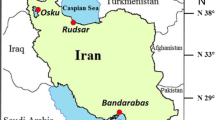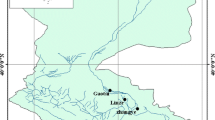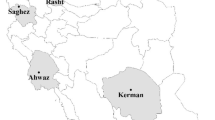Abstract
The model performance is usually influenced by the quality of the data used in model construction. If the model performance is less affected by data quality, the resulting estimates will be more reliable. In this paper, the variation in model performance due to different data quality is explored in a field-scale application. Hence, two models, the proposed support vector machine (SVM) based model and the Stephen and Stewart (SS) model, are employed for daily estimation of evaporation at an experiment station. Five scenarios corresponding to different data qualities are designed to evaluate the effect of data quality on model performance. Additionally, the most effective meteorological variables influencing evaporation are obtained by a systematic input determination process. These most effective meteorological variables are used as inputs to the SVM-based model. The results show that the model performance decreases as the data quality decreases (i.e. the percentage of missing data increases). However, the estimation accuracy of SVM-based models is still better than that of the SS model. Moreover, the variation of model performance of the SVM-based model is smaller than that of the SS model. That is, the negative impact of different data quality is effectively decreased by using the SVM-based model instead of the SS model.








Similar content being viewed by others
References
Aksoy H, Dahamsheh A (2009) Artificial neural network models for forecasting monthly precipitation in Jordan. Stoch Environ Res Risk Assess (SERRA) 23:917–931
Allen RG, Pereira LS, Raes D, Smith M (1998) Crop evapotranspiration, irrigation and drainage Paper No. 56. Food and Agriculture Organization: Rome, Italy
ASCE Task Committee on Application of Artificial Neural Networks in Hydrology (2000a) Artificial Neural Networks in hydrology, I: preliminary concepts. J Hydrol Eng 5(2):115–123
ASCE Task Committee on Application of Artificial Neural Networks in Hydrology (2000b) Artificial Neural Networks in hydrology, II: hydrological applications. J Hydrol Eng ASCE 5(2):124–137
Chen H, Xiang TT, Zhou X, Xu CY (2012) Impacts of climate change on the Qingjiang Watershed’s runoff change trend in China. Stoch Environ Res Risk Assess (SERRA) 26:847–858
Chetan M, Sudheer KP (2006) A hybrid linear-neural model for river flow forecasting. Water Resour Res 42(4):W04402. doi:10.1029/2005WR004072
Cristianini N, Shaw-Taylor J (2000) An introduction to support vector machines and other kernel-based learning methods. Cambridge University Press, New York
Guven A, Kisi O (2011) Daily pan evaporation modeling using linear genetic programming technique. Irrig Sci 29:135–145
Hosseinzadeh Talaee P, Heydari M, Fathi P, Marofi S, Tabari H (2012) Numerical model and computational intelligence approaches for estimating flow through Rockfill Dam. J Hydrol Eng 17(4):528–536
Izadifar Z, Elshorbagy A (2010) Prediction of hourly actual evapotranspiration using neural networks, genetic programming, and statistical models. Hydrol Process 24(23):3413–3425
Jahanbani H, El-Shafie AH (2011) Application of artificial neural network in estimating monthly time series reference evapotranspiration with minimum and maximum temperatures. Paddy Water Environ 9:207–220
Jeong DI, St-Hilaire A, Ouarda TBMJ, Gachon P (2012) Comparison of transfer functions in statistical downscaling models for daily temperature and precipitation over Canada. Stoch Environ Res Risk Assess (SERRA) 26:633–653
Kashani MH, Dinpashoh Y (2012) Evaluation of efficiency of different estimation methods for missing climatological data. Stoch Environ Res Risk Assess (SERRA) 26:59–71
Keskin ME, Terzi O (2006) Artificial neural network models of daily pan evaporation. J Hydrol Eng 11(1):65–70
Kisi O (2008) The potential of different ANN techniques in evapotranspiration modelling. Hydrol Process 22(14):2449–2460
Kisi O (2009a) Modeling monthly evaporation using two different neural computing techniques. Irrig Sci 27:417–430
Kisi O (2009b) Daily pan evaporation modelling using multi-layer perceptrons and radial basis neural networks. Hydrol Process 23:213–223
Kisi O, Cimen M (2009) Evapotranspiration modelling using support vector machines. Hydrol Sci J 55(8):1442–1450
Kumar M, Bandyopadhyay A, Raghuwanshi NS, Singh R (2008) Comparative study of conventional and artificial neural network-based ETo estimation models. Irrig Sci 26:531–545
Kuo SF, Chen FW, Liao PY, Liu CW (2011) A comparative study on the estimation of evapotranspiration using backpropagation neural network: Penman–Monteith method versus pan evaporation method. Paddy Water Environ 9:413–424
Landeras G, Ortiz-Barredo A, Lopez JJ (2008) Comparison of artificial neural network models and empirical and semi-empirical equations for daily reference evapotranspiration estimation in the Basque Country (Northern Spain). Agric Water Manag 95(5):553–565
Lin GF, Chen LH (2004) A non-linear rainfall-runoff model using radial basis function network. J Hydrol 289(1–4):1–8
Lin JY, Cheng CT, Chau KW (2006) Using support vector machines for long-term discharge prediction. Hydrol Sci J 51(4):599–612
Lin GF, Chen GR, Wu MC, Chou YC (2009a) Effective forecasting of hourly typhoon rainfall using support vector machines. Water Resour Res 45(8):W08440. doi:10.1029/2009WR007911
Lin GF, Chen GR, Huang PY, Chou YC (2009b) Support vector machine-based models for hourly reservoir inflow forecasting during typhoon-warning periods. J Hydrol 372(1–4):17–29
Lin GF, Chen GR, Huang PY (2010) Effective typhoon characteristics and their effects on hourly reservoir inflow forecasting. Adv Water Resour 33(8):887–898
Maity R, Bhagwat PP, Bhatnagar A (2010) Potential of support vector regression for prediction of monthly streamflow using endogenous property. Hydrol Process 24(7):917–923
Moghaddamnia A, Ghafari Gousheh M, Piri J, Amin S, Han D (2009) Evaporation estimation using artificial neural networks and adaptive neuro-fuzzy inference system techniques. Adv Water Resour 32(1):88–97
Rahimikhoob A (2009) Estimating daily pan evaporation using artificial neural network in a semi-arid environment. Theor Appl Climatol 98(1–2):101–105
Shiri J, Kisi O (2011) Application of artificial intelligence to estimate daily pan evaporation using available and estimated climatic data in the Khozestan Province (South Western Iran). J Irrig Drainage Eng ASCE 7:412–425
Shirsath PB, Singh AK (2010) A comparative study of daily pan evaporation estimation using ANN, regression and climate based models. Water Resour Manag 24:1571–1581
Stephen JC, Stewart EH (1963) A comparison of procedures for computing evaporation and evapotranspiration. Publication 62. International Association of Scientific Hydrology, International Union of Geodynamics and Geophysics, Berkeley, CA, pp 123–133
Tabari H, Marofi S, Sabziparvar AA (2010) Estimation of daily pan evaporation using artificial neural network and multivariate non-linear regression. Irrig Sci 28:399–406
Tabari H, Hosseinzadeh Talaee P, Abghari H (2012a) Utility of coactive neuro-fuzzy inference system for pan evaporation modeling in comparison with multilayer perceptron. Meteorol Atmos Phys 116:147–154
Tabari H, Kisi O, Ezani A, Hosseinzadeh Talaee P (2012b) SVM, ANFIS, regression and climate based models for reference evapotranspiration modeling using limited climatic data in a semi-arid highland environment. J Hydrol 444:78–89
Tan SBK, Shuy EB, Chua LHC (2007) Modelling hourly and daily open-water evaporation rates in areas with an equatorial climate. Hydrol Process 21(4):486–499
Vapnik VN (1995) The nature of statistical learning theory. Springer, New York
Vapnik VN (1998) Statistical learning theory. Wiley, New York
Wang WC, Chau KW, Cheng CT, Qiu L (2009) A comparison of performance of several artificial intelligence methods for forecasting monthly discharge time series. J Hydrol 374(3–4):294–306
Wu CL, Chau KW, Li YS (2008) River stage prediction based on a distributed support vector regression. J Hydrol 358(1–2):96–111
Xu ZX, Li JY (2002) Short-term inflow forecasting using an artificial neural network model. Hydrol Process 16(12):2423–2439
Yu XY, Liong SY (2007) Forecasting of hydrologic time series with ridge regression in feature space. J Hydrol 332(3–4):290–302
Zanetti SS, Sousa EF, Oliveira VPS, Almeida FT, Bernardo S (2007) Estimating evapotranspiration using artificial neural network and minimum climatological data. J Hydrol Eng 133(2):83–89
Author information
Authors and Affiliations
Corresponding author
Rights and permissions
About this article
Cite this article
Wu, MC., Lin, GF. & Lin, HY. The effect of data quality on model performance with application to daily evaporation estimation. Stoch Environ Res Risk Assess 27, 1661–1671 (2013). https://doi.org/10.1007/s00477-013-0703-4
Published:
Issue Date:
DOI: https://doi.org/10.1007/s00477-013-0703-4




